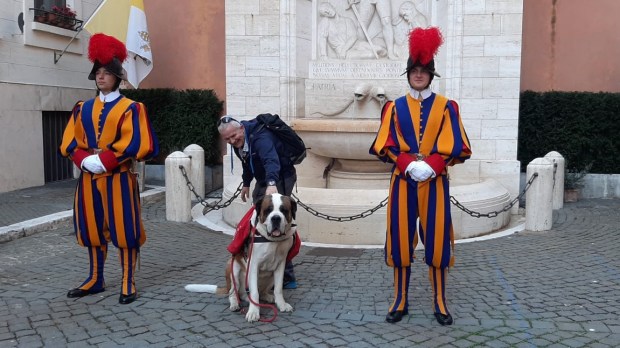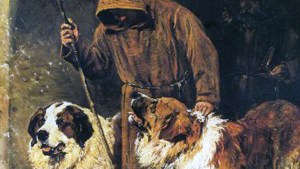Seven years after a first meeting with Pope Francis, Claudio Rossetti and his dog Magnum returned to Rome via the Via Francigena to greet the pontiff at the end of the general audience on March 29, 2023. This was an opportunity to highlight the social aspect of St. Bernard dogs, which is closely linked to the hostel of the same name founded in 1050 by St. Bernard of Menthon. The canons regular of the community contributed to the popularization of this breed of dog from the 18th century onwards, using them to help pilgrims in difficulty when crossing the pass.
“This idea of doing this path of more than 1,000 kilometers (621 miles) was an important challenge,” explained Claudio Rossetti, meeting journalists at the Swiss Guard barracks, the arrival point of the Via Francigena. The 60-year-old from Ticino (Switzerland), who is involved in Swiss cultural life, has had many other adventures such as the Venice Marathon and the organization of a press conference on Mount Kilimanjaro.
Despite the mild weather in March, this long walk was a great physical challenge for Rossetti and his dog, who was visibly tired after the effort.
The Swiss ambassador to the Holy See, Denis Knobel, humorously greeted the dog Magnum as another “ambassador” of the social and humanitarian vocation of Switzerland, called upon, because of its geographical position, to accompany pilgrims and hikers in their crossing of the Alps.
“I took this decision to return by walking after a meeting with Pope Francis in 2016,” in the context of the project to include the St. Bernard breed in the UNESCO heritage as a rescue dog, Claudio Rossetti explains to I.MEDIA. The first time he met the Pope, “the Holy Father had asked where the Saint Bernard dog’s barrel was. I promised to bring him one on foot,” says the Swiss adventurer, who says the Pope was delighted to finally be offered, seven years later, this small barrel traditionally hung around this dog’s neck.
“At first, I didn’t know how to make this journey, nor how long it would take,” he says. The choice was made to follow the Via Francigena in stages, year after year, for a total of 12 weeks. “For this last stage, we walked 75 kilometers (47 miles) from a town near Viterbo,” he says.
A dog that creates social connections
“The project was to walk alone with the dog, but it’s easy to meet people. It’s a dog that creates a bond,” explains Claudio Rossetti, who was the director of the Barry Foundation from 2015 to 2021. This association, created in 2005, is a continuation of the assistance work carried out by the dogs of the Great St. Bernard Hospice, developing the “social dog” or “therapy dog” aspect of the breed.
“Almost every day, a team composed of a dog and a companion visits hospitals, schools, and retirement homes,” he says, adding that the Foundation has a total of about 30 dogs. The Saint Bernard dogs thus contribute to the bonds among people living in sometimes isolated localities, and also bring Switzerland and Italy closer together, as they share this snowy border for most of the year.
“The Saint Bernard dog was originally a Tibetan mongrel, domesticated by the canons as a rescue dog to help pilgrims in difficulty crossing the pass, especially in case of avalanches,” explains Corrado Jordan, former mayor of Saint-Rhémy-des-Bosses, an Italian but French-speaking town of about 400 inhabitants located in the Valle d’Aosta, on the border with Switzerland.
He remembers the discreet visit of Benedict XVI to the region on July 18, 2006, during which the German pope, whose affection for animals was well known, was able to pet a few Saint Bernard dogs while visiting the Great St. Bernard Hospice. “The Italian police had to stop at the border,” says Corrado Jordan.
The Great St. Bernard Hospice is on Swiss territory, but Valle d’Aosta is linked to this religious community, which has also provided priests to some parishes located in Italian territory.
The elected official sees these Saint Bernard dogs as symbols of the “solidarity and social ties” that give rhythm to the life of this cross-border region, in which a spirit of hospitality has always been maintained, “even during the Wars,” he insists.
The difficulties encountered by Napoleon’s troops in crossing the Alps in 1800 contributed to the popularization of the Saint Bernard, as stories of the rescue of soldiers by these then still-little-known dogs circulated among the French population. The breed has made multiple appearances in popular culture, from Looney Tunes in the 1950s to the 1990s movie Beethoven. Today the dog has great visibility in popular culture as a protective and endearing family dog.




